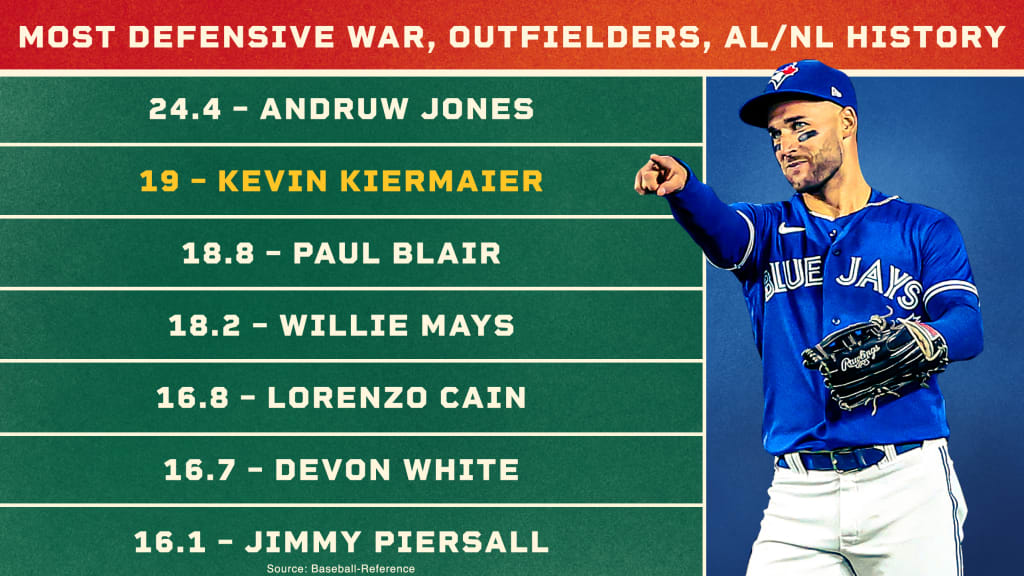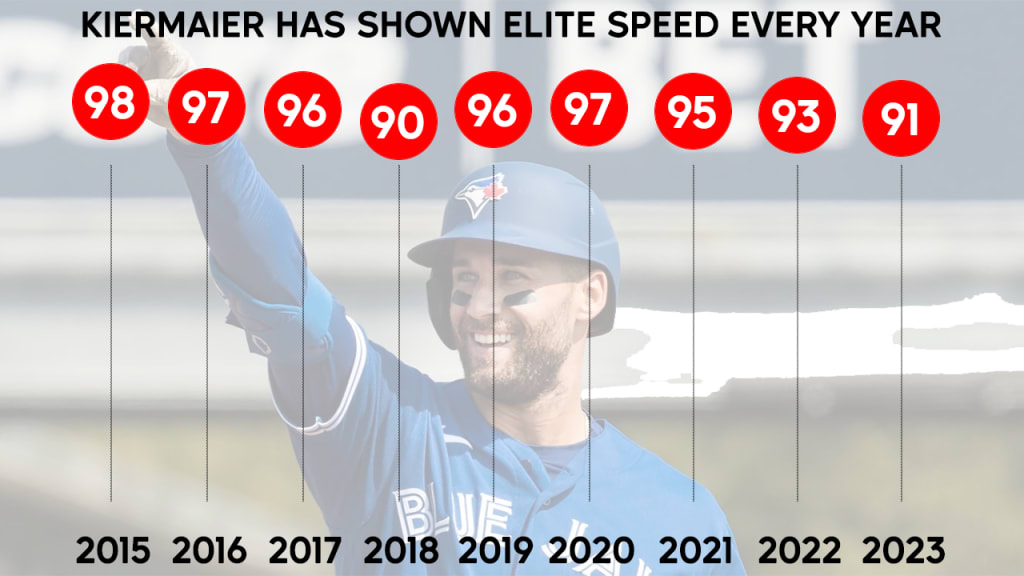Ten years ago, then-Minor Leaguer Kevin Kiermaier made the Rays' 2013 AL Wild Card roster despite the fact that he’d never started a regular-season game or even taken a plate appearance, simply on the strength of his defense. ("Hold on a minute," then-GM Andrew Friedman said at the time, upon realizing what they were doing. "Everybody in here has to appreciate that this is crazy.")
Two months ago, Kiermaier made his home debut for his new team, the Blue Jays. It took all of four batters for him to make a catch so impressive -- robbing Detroit’s Kerry Carpenter of a home run -- that teammate Alek Manoah could only react by comparing him to a superhero, saying “he’s like Spider-Man out there.”
And in between? In parts of 10 seasons since that AL Wild Card Game, Kiermaier has won three Gold Gloves and one Platinum Glove. He tops the scale in any defensive metric you can think of; he leads the world in highlight-reel catches. Even now, at 33 years old and coming off left hip surgery that truncated his final year with the Rays, at an age when most fielders are well into their decline phase, he hasn’t lost a step. He’s still playing center field. He’s still atop the defensive leaderboards. He’s still elite.
Kiermaier has never made an All-Star Game, an injustice that we’ll get back to shortly, and only once has he appeared on an MVP ballot. But after all these years, he’s squarely in the conversation for something far more impressive -- the best defensive outfielder you've ever seen.
Or, at least: He should be.
How do you measure great defense?
Statcast’s defensive metrics go back to 2016. Kiermaier, in that time, rates as the best defensive outfielder, with +78 Outs Above Average, ahead of Lorenzo Cain (+63) and Byron Buxton (+69). That's a metric which is just about range, about catching batted balls, though in a soon-to-be-released update that accounts for the value of a throwing arm, he'll be at the top of that list, too.
Since Kiermaier’s career predates Statcast, we can turn to Sports Info Solutions’ Defensive Runs Saved, which has been available since 2003 and does include arm value. Kiermaier, in that time, rates as the best defensive outfielder, with +157 runs saved, ahead of Jason Heyward (+153) and Mookie Betts (+149).
So, full stop right there: Two of the most advanced current defensive metrics available say that he’s the best outfielder they’ve ever seen, and one of them is essentially saying “the best outfielder of the 21st century.” That seems like it’s enough to at least get you into the all-time conversation.
But we didn’t say “of the 21st century,” did we? We said of all time, and that’s where it gets a little tricky.
Before Statcast’s cameras, and before SIS’s video scouts, there was Total Zone. To say it was inferior to “technology” and “people” is an understatement, but given the limitations of the data available -- it was, as you can learn more about here or here, mostly a clever estimate based on box-score data -- it actually works reasonably well, in that you will be extremely satisfied to know that the three top-rated defensive outfielders of all time through 2013, the last year before Kiermaier debuted, were Andruw Jones, Roberto Clemente and Willie Mays. (Gary Sheffield pulls up the rear.)
If you put it all together, and you look at defensive WAR -- which will give center fielders, like Kiermaier, a little extra credit for playing the harder spot over corner outfielders like Clemente -- from outfielders throughout all of history, you’ll land on this impressive list. That's Kiermaier, right up with some all-time legends.

Even understanding the obvious concerns you might have about defensive metrics from many decades ago, that’s a nicely satisfying group. No one will complain about saying that Jones (10 Gold Gloves), Blair (8 Gold Gloves) and Mays (12 Gold Gloves) are three of the four best defensive outfielders in history, will they? And if so, how could you argue against the inclusion of Kiermaier, who is beloved by more modern metrics?
(And, it should be pointed out, respected by his peers, too. Grady Sizemore, a two-time Gold Glove winner himself and briefly a Tampa Bay teammate of Kiermaier’s, once informed him that “you're the best center fielder I've ever seen!" That was back in 2015 -- before Kiermaier had even completed his second full season. Two years later, then-Rays pitcher Chris Archer claimed that "he's the best defender in the world at his position, maybe at any position.")
Still, given the limitations of ancient data, the ordering here isn’t really the point. It’s not about saying with certainty that he’s second-best or fifth-best or ninth-best. It’s that if you’ve been the best defender for an entire decade, as Kiermaier has, you should be in the conversation for one of history’s best ever -- especially when the metrics we have available say exactly that.
Besides: it’s not just that he’s been great. It’s that he’s still great, rating as 2023’s best outfielder by both Outs Above Average and Defensive Runs Saved, and that, at 33, is surprising given what we know about aging.
“A player’s defensive peak is around his age-26 season,” wrote SIS in 2020, “with a steady decline for the rest of his career, including a more substantial decline beyond their age-30 season.”
For Kiermaier, his age-26 season was in 2016, when he won his second Gold Glove, and given all the injuries since -- a broken hand in 2016, a hip issue in '17, a torn thumb ligament in '18 and the hip injury in '22, among other more minor maladies -- you’d expect to see that aging curve fully in progress.
But here, that just hasn’t happened. Kiermaier hasn’t slowed down, and he hasn’t stopped adding value in the field, year over year over year.

The arm -- the one that has fired off 10 tracked throws of 100 mph or more since 2015, the most of any player -- is still in the 98th percentile, as former teammate Wander Franco recently found out.
Perhaps most importantly, he’s once again getting the best jumps -- that’s reactions, not vertical leaps -- in the game, a skill he considers vital. He was No. 1 in baseball in 2016, the first year it was available, and he’s No. 1 again in 2023, along with excellent ratings most every year in between. It simply means that he's putting himself in position to make the great play more than any other player.
“I have the speed and the arm, but it’s my instincts that separate me from others,” he said in 2014. “I make it a point not to take one pitch off at all,” he told MLB.com in 2021. “I'm always in a ready position to go in, back, left, right, diagonal, it doesn't matter, and that's something I hold myself accountable to every single pitch.”
He’s made incredible looking plays that had a high degree of difficulty, like last month when he turned a mere 15% Catch Probability opportunity off the bat of Milwaukee’s Andruw Monasterio into a spectacular diving catch:
But it's often the lesser-seen skill -- those great reactions -- that might also make him the king of making difficult things look, well, easy, like the time back in 2016 when he robbed Baltimore's Joey Rickard.
This one probably didn't make any highlight reels, but it went down as a 25% Catch Probability (i.e., it's not made 3 out of 4 times) because he moved more than 10 feet more than than average in the first three seconds. He didn't have to leap, because he'd done the hard work at the start of the play, not the end, before the broadcast camera even shows you what he's doing. (Which points to another skill: He reads the catcher's signs and gets moving early.)
“It’s elite," said Toronto manager John Schneider recently when asked by MLB.com's Keegan Matheson. "You don’t want to say you’re used to it at this point, a couple of months in, but it’s definitely different than anyone else in the league. It’s a luxury to have. We saw it in short spurts against Tampa for years, but seeing it every day, you really appreciate the work that he does, the prep that he does and the skills that he does.”
All of which brings us back to the Scotts All-Star Game Ballot, where he is currently the active player who has accrued the most Wins Above Replacement without once making an All-Star team -- and, with another strong season or two without that recognition, he’d find himself being one of the three "best" non-decorated position players of the divisional era (since 1969). While Kiermaier will have an uphill battle to be named an All-Star starter, he did rank fifth in the most recent update, putting him in position to move on to Phase 2 of the voting.
His lack of a previous All-Star selection is in part on him -- the injuries, for sure, and the decent-but-rarely-strong bat. (Kiermaier and Jim Piersall are the only outfielders in history to have earned more WAR on defense than on offense, at least among those who managed to put up even 10 WAR on offense.) But maybe it’s on us, too, for not recognizing truly elite defense when it’s right before our eyes.
"He is as good of a defender as there is in professional baseball in our opinion," Friedman said 10 years ago, when Kiermaier was added to the Major League roster. “I believe I'm the best defensive outfielder in the game,” Kiermaier once told MLB.com, and the evidence is increasingly difficult to argue with.
It also might be selling himself short. With every great catch, with every can-you-believe-it grab, it's less about "how well does he rank today?" and more about "how well does he rank ever?" -- and the answer to that seems clear.
